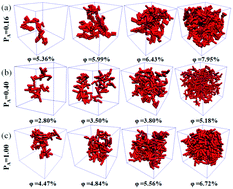Controlling the electrical conductive network formation of polymer nanocomposites via polymer functionalization†
Abstract
By adopting coarse-grained molecular dynamics simulations, the effect of polymer functionalization on the relationship between the microstructure and the electric percolation probability of nanorod filled polymer nanocomposites has been investigated. At a low chain functionalization degree, the nanorods in the polymer matrix form isolated aggregates with a local order structure. At a moderate chain functionalization degree, the local order structure of the nanorod aggregate is gradually broken up. Meanwhile, excessive functionalization chain beads can connect the isolated aggregates together, which leads to the maximum size of nanorod aggregation. At a high chain functionalization degree, it forms a single nanorod structure in the matrix. As a result, the highest percolation probability of the materials appears at the moderate chain functionalization degree, which is attributed to the formation of the tightly connected nanorod network by analyzing the main cluster. In addition, this optimum chain functionalization degree exists at two chain functionalization modes (random and diblock). Lastly, under the tensile field, even though the contact distance between nanorods nearly remains unchanged, the topological structure of the percolation network is broken down. While under the shear field, the contact distance between nanorods increases and the topological structure of the percolation network is broken down, which leads to a decrease in the percolation probability. In total, the topological structure of the percolation network dominates the percolation probability, which is not a necessary connection with the contact distance between nanorods. In summary, this work presents further understanding of the electric conductive properties of nanorod-filled nanocomposites with functionalized polymers.


 Please wait while we load your content...
Please wait while we load your content...